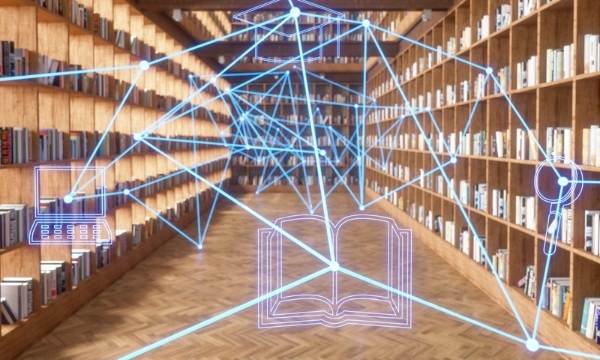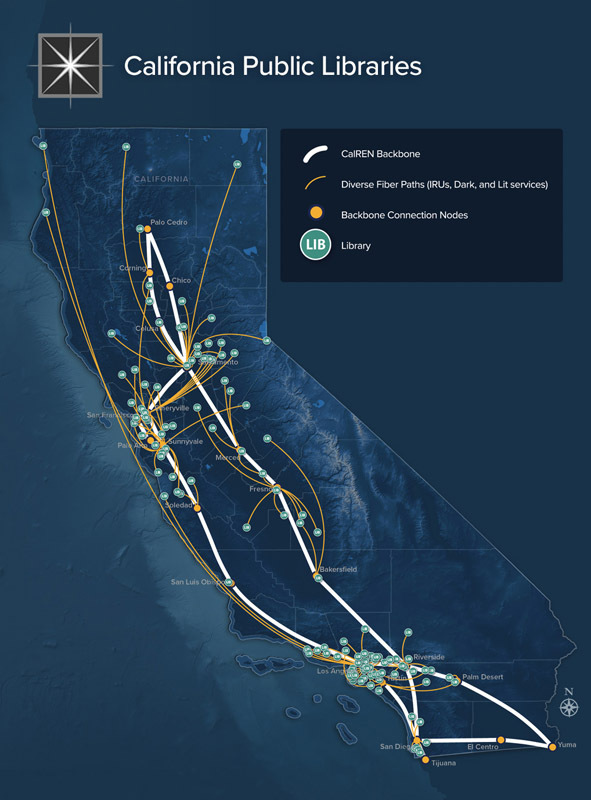- About
- Network
- Community
- Initiatives
- News
- Events
- Blog
- Publications
California Public Libraries and CENIC
CENIC supports public libraries in becoming community hubs
Widely considered the ultimate source of information, libraries have established themselves as the de facto place to turn when one needs to research a topic or simply secure a reliable Internet connection. Whether individuals are there for free WiFi, telehealth, job training, or online classes, California’s libraries have, in recent decades, emerged as digital hubs accessible to all–particularly post-pandemic.
Libraries in Action with CENIC
Libraries are unique among knowledge-driven institutions. They serve people from all walks of life and at all ages—from preschoolers to senior citizens—by connecting them with the education, training, and even research resources they need to participate in and contribute to society. Libraries also help bridge the state’s digital divide by supporting visitors with job searches, online classes, telehealth, cultural events, digital courses, and other assets that improve their lives. They’ve also become instrumental in assisting communities to respond and recover from disasters like wildfires.
Before joining CENIC, three-quarters of California’s libraries had very slow Internet connections—at or below 2 Megabits per second, far slower than many private homes. For two-thirds of libraries, these connections would fill soon after they opened their doors for the day.
Many libraries are now connected to the Internet 10 to 100 times faster than before. Of the 900+ libraries connected to CalREN either directly or behind a directly connected main branch, most connect at speeds between 1–5 Gbps, with over 50 connecting at 10 Gbps and two at 100 Gbps. The Los Angeles Public Library was the first public library in the world with a 100 Gbps connection. Without CENIC, this level of connectivity would not be possible for libraries without tough or even impossible trade-offs.
With these improvements, Californians of all ages can trust their libraries to provide a high level of connectivity to online resources worldwide and a robust, best-in-class network path to California K–12 schools, institutions of higher learning, cultural and healthcare institutions, and more.
CENIC membership also allows libraries to overcome any limitations presented by their physical infrastructure. In some library systems, older buildings make it difficult to maintain reliable, on-site network infrastructure. However, improved connectivity through CENIC has opened the door to cloud-based solutions that provide greater flexibility and resilience.

CENIC partners with national and international research and education networks, governmental networks, and commercial networks to expand access, working to support broad public access to the educational, research, and cultural assets that position California for a prosperous future.
Positioning Communities for the Future
The California State Library and California public libraries are critical to community connectivity. Together, CENIC and libraries open horizons, prepare people for various opportunities, and create a digitally empowered state. This is especially true during these post-pandemic times when libraries are used for everything from telehealth appointments and job applications to digital downloads and remote work.
More than Ten Years of Milestones

2012: Nine county libraries in CA’s Northern Central Valley connect to CalREN
North Central Valley libraries extend internet access and digital literacy to low-income and immigrant populations.

2013: CENIC and San Joaquin Valley Library System conduct needs assessment
The San Joaquin Valley Library System connects to CalREN, supporting residents with high rates of poverty, unemployment, and homelessness.

2015: Lighting Up Libraries: High-speed Broadband in California Public Libraries
Fifty-four library jurisdictions with 389 individual libraries—about one-third of the state’s public libraries—are poised to dramatically increase their bandwidth while cutting their monthly service charges by nearly two-thirds.

2016: CENIC operates the two of the largest E-rate consortia in the U.S
One serves public libraries and the other library systems and includes 50 certified E-rate applications with 187 funding requests submitted.

2017: The Los Angeles Public Library becomes the first 100-Gigabit library in the US
Upgraded CalREN connectivity allows for speeds 1,000 times faster than previously delivered.

2020: Libraries across California continue to receive high-speed broadband
More than 900 of the state’s 1,128 libraries have been connected to the same high-speed broadband network as the University of California, the state university system, community colleges, and public schools.

2021: State funding is approved
The State of California approves $35M to continue funding high-speed connections for California State Libraries.

2022: CENIC launches a new notification database
The new database communicates targeted outages and maintenance announcements to impacted libraries.

2024: Imperial County Office of Education selected as broadband aggregator
The selection simplifies connectivity for public libraries, enabling more libraries and their communities to receive high-speed broadband connectivity.



